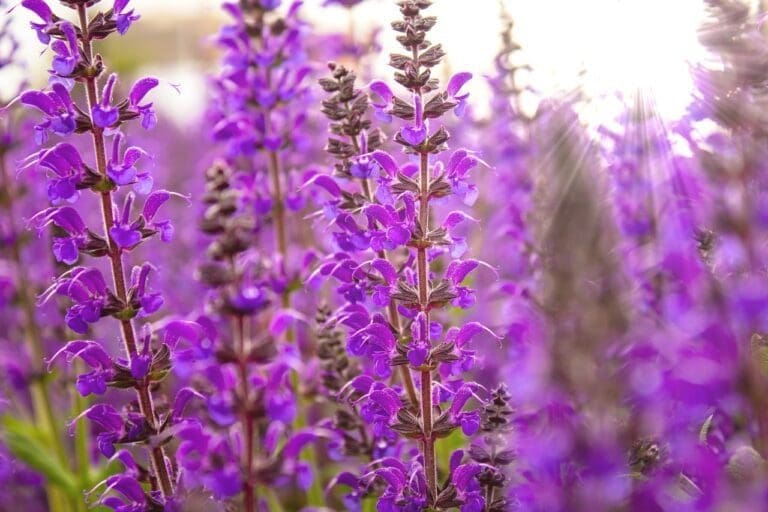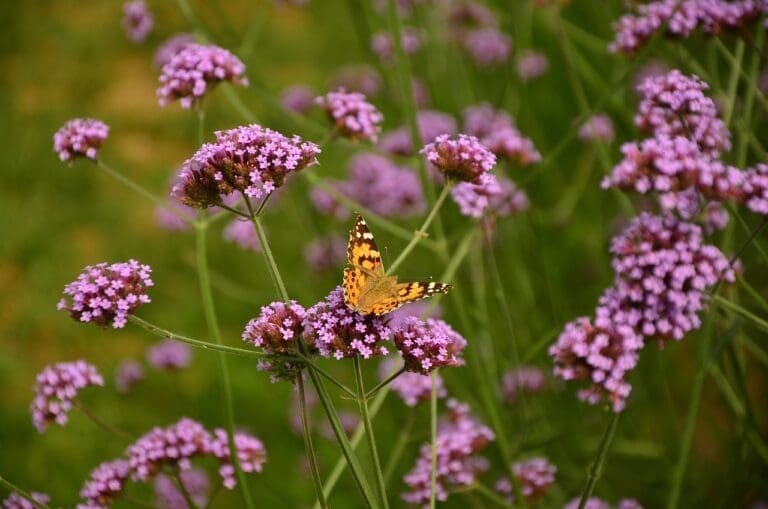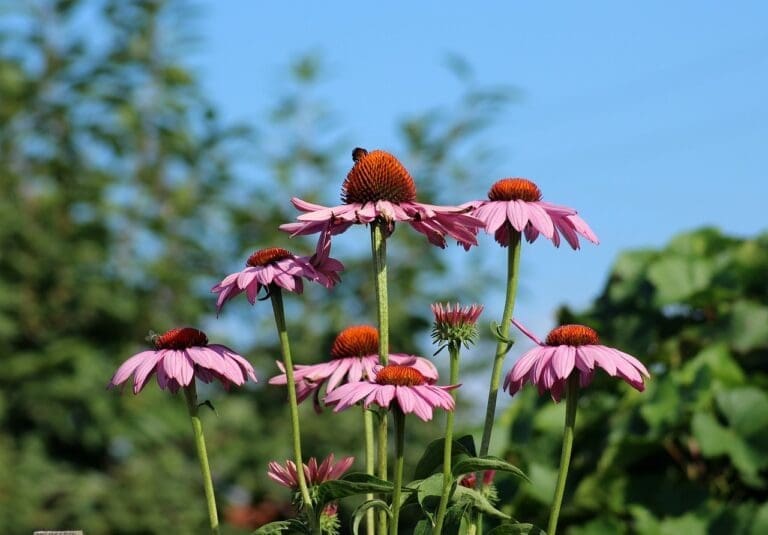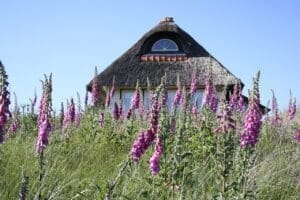As climate change continues to show its impact through frequent drought spells in the UK, it’s wise to consider a greener approach.
One way of doing this is by choosing plants that are perfectly suited to these drier conditions for your garden. Not only are these ten plants we’ve chosen able to weather the drought, but they’ll also add a splash of beauty to your garden, making it an oasis even during parched times.
The beauty of drought-resistant plants is that they require less watering, which not only saves you time, but also helps reduce your overall water consumption in the garden.
Top Tip
For a low-maintenance garden that thrives in dry conditions, mix and match these drought-tolerant plants, ensuring you balance flowering plants with ornamental grasses for an aesthetically pleasing, resilient outdoor space.
Here are our top 10 drought-resistant plant suggestions perfect for the UK garden:
1. Crocosmia
2. Salvia Nemorosa – ‘Caradonna’
3. Sedums
4. Lavender
5. Echinacea
6. Nepeta
7. Festuca Glauca
8. Descampsia Cespitosa
9. Succulents
10. Alliums
1. Crocosmia

Native to South Africa, the Crocosmia plant can stand the heat once it has settled in your garden. Initial watering after planting is necessary, but after this stage, they thrive with minimal attention.
They’re easy to grow and are expected to bloom from mid to late summer. Although they prefer full sun, they’re also quite adaptable and can handle a bit of shade.
2. Salvia Nemorosa – ‘Caradonna’


This perennial is a gem in any garden, especially for those looking for a naturalistic style. Native to central eastern Europe, Salvia Nemorosa is a reliable, easy-to-maintain plant that thrives in sunny spots.
Its spires of purple flowers not only look great but also attract pollinators from June until October, making your garden a buzzing, vibrant space.
3. Verbena Bonariensis


Perfect for a naturalistic style, it pairs beautifully with ornamental grasses like Stipa tennuisima and Descampsia Cespitosa. While it does need some watering at first, it’s pretty good at handling dry spells later.
Here’s a little secret from my garden: although often grown as annuals, my Verbena Bonariensis keep coming back each year. Just give them a trim in autumn when they get a bit messy. A word of caution, though: they love to self-seed, so expect some little surprises popping up around your garden!
4. Sedums
Sedums, with their nectar-rich flowers, are a bee’s delight from June to August. They’re drought-resistant, and some varieties can also withstand frost, making them a hardy choice for UK gardens. Simply place them in a sunny position, and they’ll reward you with their beauty. Their dead flower heads can be left over winter, providing food for insects and birds.
5. Lavender


A classic choice for many UK gardens, Lavender, native to the Mediterranean region, is also drought-resistant. It’s ideal for bordering walkways or seating areas where you can enjoy its fragrant flowers. These flowers will also attract a plethora of bees throughout the summer. Lavender plants require little upkeep and maintain their compact shape if trimmed annually after flowering.
6. Echinacea Purpurea


Increasingly popular in the UK, Echinacea Purpurea is a fantastic choice if you’re looking for a drought-resistant, low maintenance plant. Their large, bright daisy-like flowers bloom from June until September. Regular deadheading can encourage more flowers, and their seedheads can be left intact during autumn for the local birds to enjoy.
7. Nepeta catmint


Also known as catmint, Nepeta is a perennial plant native to Europe and Asia that stands up well to warmer temperatures and dryer spells. This low maintenance plant contrasts beautifully with its deep violet flowers, attracting plenty of butterflies. Depending on the variety, Nepeta usually flowers from early summer until autumn.
8. Festuca Glauca


If you’re considering ornamental grasses that can handle the heat, Festuca Glauca, also known as Blue Fescue, is worth considering. This drought-resistant grass, native to Europe and Asia, adds a contrast to your garden borders or containers. Its dense, silvery-blue foliage can offer ground cover, particularly along pathways or border fronts. It’s easy to maintain and can be divided in the spring.
9. Descampsia Cespitosa
Also known as Tufted Hair Grass, Descampsia Cespitosa is a perennial grass that can withstand drought conditions once established in the UK. This grass creates cloud-like flowers from June onwards, making it a fantastic option for those looking to create a more natural, wilder aesthetic in their garden.
10. Alliums


Perennial Allium bulbs are a vibrant and drought-tolerant addition to any garden. Best planted in the autumn months, from September through to early December, Alliums offer vibrant bursts of colour and start showing growth signs in spring. If you’re interested in planting Alliums, make sure to check out our related blog post here.
Each of these plants has unique properties that make them both beautiful and hardy. If you’re planning a garden that’s both eye-catching and environmentally friendly, you really can’t go wrong with any of these choices.
So, let’s start making our gardens more climate-change resilient, one plant at a time. Happy planting!
Design Ideas for a Drought-Tolerant Garden


Creating a drought-tolerant garden doesn’t mean you need to compromise on style or beauty. Here are some design ideas that will help you create a stunning garden that’s both water-wise and full of life.
Plant Grouping
Group plants with similar water needs together. This technique, called hydrozoning, not only saves water but also reduces maintenance. For instance, pairing succulents, Salvia Nemorosa, and Alliums together would create a visually appealing combination that thrives on less water.
Create a Focal Point
Use drought-tolerant plants to create a striking focal point in your garden. A group of Echinacea Purpurea or a beautifully pruned lavender bush can draw the eye and set the scene for the rest of your garden.
Mix Heights and Textures
Just like any other garden design, a mix of plant heights and textures can add interest and depth. Plant taller species like the Verbena Bonariensis or Descampsia Cespitosa at the back of your borders, with shorter plants like Nepeta and Sedums at the front.
Use Ornamental Grasses
Ornamental grasses such as Festuca Glauca and Descampsia Cespitosa add motion to your garden as they sway in the breeze. They can be used as border plants, ground covers, or even as privacy screens.
Consider Colour
Plan your garden so that some plants are in bloom at all times. This will ensure that your garden is colourful throughout the year. The vibrant Crocosmia can provide late summer colour, while Salvia Nemorosa and Lavender bloom from spring through to autumn.
Frequently Asked Questions
Q: Are Salvias drought tolerant?
Salvias, specifically the Salvia Nemorosa variety, are well-known for their drought tolerance. Once established, they can thrive in dry conditions. They are native to central eastern Europe, which makes them accustomed to surviving in drier climates.
Q: When should I cut back Salvias in the UK?
Salvias should typically be cut back in the late spring in the UK, around late May to early June. This is after the risk of late frosts, which could harm new growth. Trimming them back encourages bushier growth and more flowers. Some varieties of Salvia may benefit from a second lighter trim in late summer to promote additional blooming.
Q: How do you make a drought-tolerant garden in the UK?
Creating a drought-tolerant garden involves several steps. Firstly, choose the right plants that are known for their drought resistance, such as the ones listed in this blog post. Then, improve your soil with organic matter to increase its water-retention capability. Mulch your plants to help keep the soil cool and slow down evaporation. Try to group plants together that have similar water needs – a technique known as hydrozoning. Additionally, consider setting up a rainwater harvesting system to use for watering during drier periods.
Q: What shrubs grow in poor dry soil?
There are quite a few shrubs that can tolerate poor, dry soils. Some of these include the Buddleia (also known as Butterfly Bush), which is loved by pollinators; the hardy Cistus (or Rock Rose), which thrives in well-drained soil in a sunny position; and the Lavender, which is drought-resistant and adored for its fragrance and colour. Other examples include Rosemary and various species of Juniper. Always check the specific needs of the shrub as some may prefer acidic or alkaline soils, even if they are drought-tolerant.







